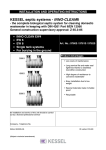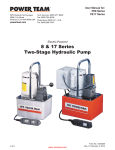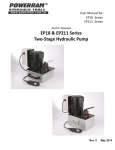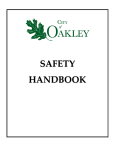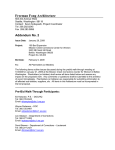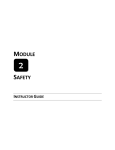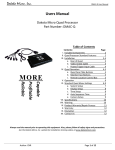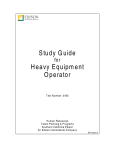Download Heavy Equipment/Mobile Equipment Policy Last Up
Transcript
Policy Number – 66 Last Update: Effective Date: 11/22/11 Resolution No. 475-11 July 14, 2010 Title : Heavy Equipment/Mobile Equipment Policy POLICY STATEMENT The use of heavy equipment/mobile equipment is a common part of many jobs conducted by Cayuga County employees. Cayuga County recognizes the hazards associated with the operation of heavy equipment/mobile equipment, and has developed this policy to establish guidelines in an attempt to eliminate injuries or fatalities related to this type of equipment. Cayuga County has a sincere concern for the welfare and safety of all County employees and the public they serve, with the goal of eliminating suffering and the cost of avoidable personal injury and illness. The County is dedicated to assuring that every job is conducted safely, and that operational expediency, including the use of short cuts, does not compromise the safety and well being of employees and the public. This policy applies to all free moving mobile equipment that may be propelled by gasoline, propane, diesel or electricity, however the policy is not intended for operators of licensed and registered (by the Department of Motor Vehicles) automobiles and similar motor vehicles intended for use by licensed motor vehicle operators on public roads and highways. Examples of Heavy Equipment/Mobile Equipment covered by this policy include but are not limited to: Backhoes Loaders Dump Trucks Dozers Tractors Bucket Truck Rollers Sweepers Excavators Skid-Steers Mini-Skid Steer Compact Tractor Mower All Terrain Vehicles Graders Mini-Excavator Boom Trucks Forklifts Golf Carts Sand/salt spreader Snow Plow Only competent personnel may operate heavy equipment/mobile equipment. An individual’s competency must be demonstrated by successful completion of the training and evaluation process specified in this policy. This policy establishes requirements to work in or around all types of mobile equipment. The requirements defined in this policy describe the minimum required by the County. In addition, the operation of some equipment may require the operator to possess other licenses (i.e., Commercial Drivers License, Forklift License) or specialty training required by the State or other regulatory agency. 1 RESPONSIBILITIES AND AUTHORITY The following identifies some of the responsibilities for various parties affected by this policy. County Management (County Legislature, Compliance Officer, County Administrator and/or their Appointed Risk Management Committee) Ensuring that Federal, State and Local laws, regulations, codes and ordinances are followed. Developing policies, accident prevention methods, procedures and programs. Conducting periodic safety inspections of all work locations. Assuring that accidents and hazardous conditions are investigated and corrective actions are implemented. Provide/Arrange for assistance with the policy to requesting departments. Department Heads Department Heads are responsible for: Identifying the specific jobs or individuals to whom this policy applies. Identifying all heavy equipment/mobile equipment in their department. Ensuring that a competent person is available for heavy equipment/mobile equipment training and evaluations. Ensure that operators of heavy equipment/mobile equipment are trained, evaluated, observed and given skills needed to operate the equipment safely. Assuring that Operator’s manuals and manufacturer’s safety information is available for all equipment and vehicles identified in the department. Ensuring that safety procedures presented in this and other County policies, as well as in Manufacturer’s Operator’s and Safety Manuals are implemented and enforced. Maintaining training and certification records for all operators of heavy equipment/mobile equipment. Supervisors Due to their constant contact with employees, supervisors must take a primary role in the prevention of accidents and the safety of employees under their supervision. Supervisor’s responsibilities include: Observing and evaluating the use of heavy equipment/mobile equipment by employees and correcting any unsafe conditions or practices and reporting or correcting any found. 2 Checking and ensuring that heavy equipment/mobile equipment is properly maintained and in safe operating condition. Remove from service, any heavy equipment/mobile equipment that is not safe. Promptly investigating all accidents and completing required reports. Encouraging employees to report all unsafe conditions and practices. Being familiar with and enforcing all safety procedures and practices applicable to work done by their employees. Employees/Heavy Equipment/Mobile Equipment Operators Employee responsibilities include: Reading, understanding and following the procedures and practices outlined in this policy. Reading, understanding and complying with owner’s manuals and manufacturer-provided safety information before using heavy equipment/mobile equipment. Completing the Daily Heavy/Mobile Equipment Checklist before use. Report any inspection deficiencies with equipment to their immediate supervisor for maintenance or further action prior to operation of the equipment Using all appropriate safety equipment and devices, including but not limited to seatbelts. Immediately reporting all work related accidents, fuel spills, fires, and injuries to their supervisors. Obey traffic signs and signals and audible or visual warning devices. Immediately reporting all unsafe conditions and practices to their supervisors and/or Department Head and/or County Administrator. Attending appropriate training as recommended by their supervisors. Competent Person (Equipment Trainer): Train and evaluate equipment operators in classroom, hands-on training process and refreshers. Be knowledgeable and experienced in the particular equipment operation and how-to train. Document evaluations and training. DEFINITIONS Competent Person – Person who by possession of a recognized degree in an applicable field or a certificate of professional standing, or who by extensive knowledge, training and experience, has successfully demonstrated the ability to 3 solve or resolve problems relating to the subject matter and work. Free Moving Mobile Equipment – Operator controlled mobile equipment not constrained by Fixed Rails and can include Industrial Fork Trucks, Aerial Lifts, Buggies, Sweepers and Backhoes. Mobile Equipment – Free moving equipment propelled/powered by gasoline, propane, natural gas, diesel or electricity used to haul, transport, excavate, move, maneuver, or hoist materials, equipment, products or personnel. Pre-use Inspection – Required inspection of a piece of mobile equipment completed when the facility has not operated the mobile equipment for each shift. Heavy Equipment/Mobile Equipment Operations General Requirements All vehicles must have a service brake system, an emergency brake system, and a parking brake system. These systems may use common components, and must be maintained in operable condition. Whenever visibility conditions warrant additional light, all vehicles in use must be equipped with at least two headlights and two taillights in operable condition. All vehicles, or combination of vehicles, must have brake lights in operable condition regardless of light conditions. All vehicles must be equipped with an adequate audible warning device at the operator's station (horn) in an operable condition. No employer may use any motor vehicle equipment having an obstructed view to the rear unless: The vehicle has a reverse signal audible above surrounding noise level. The vehicle backs up only when an observer signals it is safe to do so. All vehicles with cabs must be equipped with windshields and powered wipers. Cracked and broken glass must be replaced. Vehicles operating in areas or under conditions that cause fogging or frosting of the windshields must be equipped with operable defrosting devices. All haulage vehicles, whose pay load is loaded by means of cranes, power shovels, loaders, or similar equipment, must have a cab shield and/or canopy adequate to protect the operator from shifting or falling materials. Tools and material will be secured to prevent movement when transported in the same compartment with employees. Vehicles used to transport employees must have seats firmly secured and adequate for the number of employees to be carried. Seat belts and anchorages meeting the requirements of 49 CFR Part 571 (Department of Transportation, Federal Motor Vehicle Safety Standards) must be installed in all motor vehicles, and used by the operator. Trucks with dump bodies must be equipped with positive means of support, permanently attached, and capable of being locked in position to prevent 4 accidental lowering of the body while maintenance or inspection work is being done. Operating levers controlling hoisting or dumping devices on haulage bodies must be equipped with a latch or other device which will prevent accidental starting or tripping of the mechanism. Trip handles for tailgates of dump trucks will be so arranged that, in dumping, the operator will be in the clear. All rubber-tired motor vehicle equipment manufactured on or after May 1, 1972, must be equipped with fenders. Mud flaps may be used in lieu of fenders whenever motor vehicle equipment is not designed for fenders (such as dump trucks where the dump bed forms an effective fender). All vehicles in use must be checked at the beginning of each shift to assure that the following parts, equipment, and accessories are in safe operating condition and free of apparent damage that could cause failure while in use: Service Brakes (including any trailer brake connections) Parking System (hand brake) Emergency Stopping System (Brakes) Tires Safety Devices Horn Steering Mechanism Coupling Devices Seat Belts Operating Controls Operators will complete the Daily Heavy/Mobile Equipment Checklist (Appendix A) every day that a piece of equipment is used, prior to using that equipment. All defects will be corrected before the vehicle is placed in service. These requirements also apply to equipment such as lights, reflectors, windshield wipers, defrosters, fire extinguishers, etc., where such equipment is necessary. General Safety Requirements for Earthmoving Equipment These OSHA/PESH rules apply to the following types of earthmoving equipment: scrapers, loaders, crawler (track) or wheel tractors, bulldozers, off-highway trucks, graders, agricultural and industrial tractors, and similar equipment. Following are OSHA/PESH's general requirements for earth moving equipment: Seat Belts Seat belts must be provided on all equipment listed above, and must meet the requirements of the Society of Automotive Engineers (SAE). 5 Tractors listed above must have seat belts as required for the operators when seated in the normal seating arrangement for tractor operation, even though back-hoes, breakers, or other similar attachments are used on these machines for excavating or other work. Access Roadways and Grades No employer may move or cause to be moved construction equipment or vehicles upon any access roadway or grade unless the access roadway or grade is constructed and maintained to accommodate safely the movement of the equipment and vehicles involved. Every emergency access ramp and berm used by an employer will be constructed to restrain and control runaway vehicles. Brakes All earthmoving equipment must have a service braking system capable of stopping and holding the equipment fully loaded. Fenders Pneumatic-tired earth-moving haulage equipment (trucks, scrapers, tractors, and trailing units) whose maximum speed exceeds 15 miles per hour must be equipped with fenders on all wheels. Rollover Protective Structures (ROPS) Rollover protective structures must meet the requirements of 29 CFR 1926.1001 Minimum performance criteria for rollover protective structures for designated scrapers, loaders, dozers, graders, and crawler tractors. Audible Alarms All bidirectional machines, such as rollers, compacters, front-end loaders, bulldozers, and similar equipment, must be equipped with a horn, distinguishable from the surrounding noise level, which can be operated as needed when the machine is moving in either direction. The horn must be maintained in an operating condition. Earthmoving equipment with an obstructed view to the rear will not be used in reverse gear unless 1) the equipment has in operation a reverse signal alarm distinguishable from the surrounding noise level, or 2) a ground guide signals that it is safe to do so. Scissor Points Scissor points on all front-end loaders or articulating equipment, which constitute a hazard to the operator during normal operation, must be guarded. Lift trucks, Stackers, etc. 6 Equipment of this type must have the rated capacity clearly posted on the vehicle so as to be clearly visible to the operator. When auxiliary removable counterweights are provided by the manufacturer, corresponding alternate rated capacities also must be clearly shown on the vehicle. These ratings will not be exceeded. Modifications or Additions No modifications or additions which affect the capacity or safe operation of the equipment may be made without the manufacturer's written approval. If such modifications or changes are made, the capacity, operation, and maintenance instruction plates, tags, or decals will be changed accordingly. In no case will the original safety factor of the equipment be reduced. Steering or Spinner Knobs Steering or spinner knobs must not be attached to the steering wheel unless the steering mechanism is of a type that prevents road reactions from causing the steering wheel to spin. The steering knob must be mounted within the periphery of the wheel. Operator Training Safe Operation The employer must ensure that each heavy equipment/mobile equipment operator is competent to operate the equipment safely, as demonstrated by the successful completion of the training and evaluation specified in this section. Prior to permitting an employee to operate heavy equipment/mobile equipment (except for training purposes), the employer must ensure that each operator has successfully completed the training required by this section. Training Program Implementation Trainees may operate heavy equipment/mobile equipment only: • Under the direct supervision of persons who have the knowledge, training, and experience to train operators and evaluate their competence. • Where such operation does not endanger the trainee or other employees. Training will consist of a combination of formal instruction (e.g., lecture, discussion, interactive computer learning, video tape, written material), practical training (demonstrations performed by the trainer and practical exercises performed by the trainee), and evaluation of the operator's performance on the job-site. All operator training and evaluation will be conducted by persons who have the knowledge, training, and experience to train heavy equipment/mobile equipment operators and evaluate their competence. 7 Training Program Content Heavy equipment/mobile equipment operators must receive initial training in the following topics, except in topics which the employer can demonstrate are not applicable to safe operation of the equipment in the employer's workplace. Training will be documented on the Heavy Equipment/Mobile Equipment Operator Training Certification Form presented as Appendix B. All training documentation will be maintained by the Department Head. Equipment-Related Topics Operating instructions, warnings, and precautions for the types of equipment the operator will be authorized to operate. Employee will read and understand Owners/Operators Manual and any other safety information provided by the manufacturer of the equipment. Trainer will review this information with the trainee, and should incorporate additional information about specific equipment based on previous experiences with the equipment. Differences between the equipment and an automobile (e.g., turn radius, braking ability, visibility of surroundings, blind spots, etc.) Equipment controls and instrumentation; where they are located, what they do, and how they work. Engine or motor operation. Steering and maneuvering. Visibility (including restrictions due to loading). Implement and attachment adaptation, operation, and use limitations. Equipment capacity. Vehicle stability. Any equipment inspection and maintenance that the operator will be required to perform. Daily Heavy/Mobile Equipment Checklist (See Appendix A) Refueling and/or charging and recharging of batteries. Refer to Cayuga County Fueling and Fuel Handling Safety Policy Operating limitations. Any other operating instructions, warnings, or precautions listed in the operator's manual for the types of equipment that the employee is being trained to operate. Workplace-Related Topics Surface conditions where the equipment will be operated. Composition of loads to be carried and load stability. Load maneuvering, loading, and unloading (includes trucks, hoppers, etc.). Pedestrian traffic in areas where the equipment will be operated. 8 Confined areas and other restricted places where equipment will be operated. Hazardous (classified) locations where the equipment will be operated. Ramps and other sloped surfaces that could affect the vehicle's stability. Closed environments and other areas where insufficient ventilation or poor vehicle maintenance could cause buildup of carbon monoxide or diesel exhaust. Other unique or potentially hazardous environmental conditions in the workplace that could affect safe operation. Refresher Training and Evaluation Refresher training, including an evaluation of the effectiveness of that training, must be conducted as required below to ensure that the operator has the knowledge and skills needed to operate the heavy equipment. Refresher training in relevant topics will be provided to the operator when: The operator has been observed to operate the equipment in an unsafe manner. The operator has been involved in an accident or near-miss incident. The operator has received an evaluation that reveals that the operator is not operating the equipment safely. The operator is assigned to operate a different type of equipment. A condition on the job-site changes in a manner that could affect safe operation of the equipment. An evaluation of each heavy equipment operator's performance will be conducted at least once every three years. Employer Certification will be documented on the form provided as Appendix C. Avoidance of Duplicative Training If an operator has previously received training in a topic specified in this section, and such training is appropriate to the equipment and working conditions encountered, additional training in that topic is not required if the operator has been evaluated and found competent to operate the equipment safely. Certification The employer will certify that each operator has been trained and evaluated as required by this section. The certification will include the name of the operator, the date of the training, the date of the evaluation, and the identity of the person(s) performing the training or evaluation. Appendix C presents a Heavy Equipment Operator Evaluation/Employer Certification Form that will be completed upon initial or refresher training of the operator, and at a minimum frequency of every three years thereafter. 9 Equipment Operations OSHA has listed safety rules for the operation of equipment. These rules are general in nature and are not intended as a comprehensive guide to the safe operations of specific pieces of heavy equipment: Equipment will not be driven up to anyone standing in front of an excavation or a fixed object. No person will be allowed to stand or pass under the elevated portion of any equipment, whether loaded or empty. Unauthorized personnel will not be permitted to ride on heavy equipment/mobile equipment. A safe place to ride will be provided where riding of equipment is authorized. The employer will prohibit arms or legs from being placed between the moving parts of the equipment, or outside the running lines of the vehicle. When heavy equipment/mobile equipment is left unattended, implements will be fully lowered, controls will be neutralized, power will be shut off, and brakes set. Wheels will be blocked if the vehicle is parked on an incline. Heavy equipment/mobile equipment is considered unattended when the operator is 25 ft. or more away from the vehicle which remains in his view, or whenever the operator leaves the vehicle and it is not in his view. When the equipment operator is dismounted and within 25 ft. of the machine still in his view, the implements will be fully lowered, controls neutralized, and the brakes set to prevent movement. A safe distance will be maintained from the edge of ramps or platforms while on any elevated surface, and from the edge of any excavation. Brakes will be set and wheel blocks will be in place to prevent movement of trucks, trailers, or railroad cars while loading or unloading. Fixed jacks may be necessary to support a semi-trailer during loading or unloading when the trailer is not coupled to a tractor. The flooring of trucks, trailers, and railroad cars will be checked for breaks and weakness before they are driven onto. There must be sufficient headroom under overhead installations, lights, pipes, sprinkler system, etc. for the safe passage of equipment. An overhead guard will be used as protection against falling objects. It should be noted that an overhead guard is intended to offer protection from the impact of small objects, representative of the job application, but not to withstand the impact of a falling capacity load. A load backrest extension will be used whenever necessary to minimize the possibility of the load or part of it from falling rearward. Only approved heavy equipment/mobile equipment will be used in hazardous locations. Traveling (Roading) Heavy/Mobile Equipment 10 All traffic regulations must be observed, including authorized site speed limits. A safe distance must be maintained approximately three vehicle lengths from the vehicle ahead, and the equipment must be kept under control at all times. The right of way will be yielded to ambulances, fire trucks, or other vehicles in emergency situations. Other vehicles traveling in the same direction at intersections, blind spots, or other dangerous locations may not be passed. The operator will be required to slow down and sound the horn at cross intersections of roadways, paths, and other locations where vision is obstructed. If the load being carried obstructs forward view, the operator will be required to travel with the load trailing (to the rear). Railroad tracks must be crossed diagonally wherever possible. Parking closer than 8 feet from the center of railroad tracks is prohibited. The operator is required to look in the direction of, and keep a clear view of the path of travel. Grades must be ascended or descended slowly. When ascending or descending grades in excess of 10 percent, loaded equipment will be driven with the load upgrade. On all grades the load and load carrying implement must be tilted back if applicable, and raised only as far as necessary to clear the road surface. Under all travel conditions the equipment must be operated at a speed that will permit it to be brought to a stop in a safe manner. Stunt driving and horseplay will not be permitted. The operator will be required to slow down for wet and slippery surfaces. Ramps or bridge plates will be properly secured before they are driven over. Ramps or bridge plates will be driven over carefully and slowly and their rated capacity never exceeded. Running over loose objects on the roadway surface will be avoided. While negotiating turns, speed will be reduced to a safe level by means of turning the hand steering wheel in a smooth, sweeping motion. Except when maneuvering at a very low speed, the hand steering wheel will be turned at a moderate, even rate. Loading Only stable or safely arranged loads will be handled. Caution will be exercised when handling off-center loads which cannot be centered. The bucket should be struck to avoid scattering loads before traveling with equipment. Only loads within the rated capacity of the equipment will be handled. Long or high (including multiple-tiered) loads which may affect capacity will be adjusted. A load must be securely within the bucket or hopper as far as possible; the bucket must be carefully tilted backward to stabilize the load. 11 Extreme care must be used when tilting the load forward or backward when the load is elevated. Tilting forward with the bucket elevated will be prohibited except to pick up a load. An elevated load will not be tilted forward except when the load is in a deposit position over a hopper or stack. All personnel not within a guarded enclosure must stay clear of loading operations. Drivers of trucks being loaded must remain in the cab, if it is equipped with overhead protection, or remain well clear of the operation. Servicing and Maintenance of Heavy/Mobile Equipment If at any time heavy/mobile equipment is found to be in need of repair, defective, or in any way unsafe, the machine will be taken out of service until it has been restored to safe operating condition. Fuel tanks must not be filled while the engine is running. Spillage of oil or fuel must be carefully washed away or completely evaporated and the fuel tank cap replaced before restarting engine. No equipment will be operated with a leak in the fuel system until the leak has been repaired. Open flames must not be used for checking electrolyte level in storage batteries or gasoline level in fuel tanks. All repairs will be made by authorized personnel. No repairs will be made in Class I, II, and III locations. Class I locations Locations in which flammable gasses or vapors are, or may be present in the air in quantities sufficient to produce explosive or ignitable mixtures Class II locations Locations which are hazardous because of the presence of combustible dust. Class III locations Locations where easily ignitable fibers are present but not likely to be in suspension in quantities sufficient to produce ignitable mixtures. Those repairs to the fuel and ignition systems of equipment which involve fire hazards will be conducted only in locations designated for such repairs. Equipment in need of repairs to the electrical system will have the battery disconnected prior to such repairs. All parts of any heavy/mobile equipment requiring replacement will be replaced only by parts equivalent as to safety with those used in the original design. Equipment will not be altered so that the relative positions of the various parts are different from what they were when originally received from the manufacturer, nor will they be altered either by the addition of extra parts not 12 provided by the manufacturer or by the elimination of any parts, except for fuel system conversions. Equipment will be examined before being placed in service, and will not be placed in service if the examination shows any condition adversely affecting the safety of the vehicle. Inspections will be made at least daily. Where heavy/mobile equipment is used on a round-the-clock basis, it will be examined after each shift. Defects when found will be immediately reported and corrected. Water mufflers must be filled daily or as frequently as is necessary to prevent depletion of the supply of water below 75 percent of the filled capacity. Vehicles with mufflers having screens or other parts that may become clogged will not be operated while such screens or parts are clogged. Any vehicle that emits hazardous sparks or flames from the exhaust system will immediately be removed from service and not returned to service until the cause for the emission of such sparks and flames has been eliminated. When the temperature of any part of any equipment is found to be in excess of its normal operating temperature, thus creating a hazardous condition, the equipment will be removed from service and not returned to service until the cause for such overheating has been eliminated. Heavy/mobile equipment will be kept in a clean condition, free excess oil, and grease. Noncombustible agents should be used for cleaning equipment. Low flash point (below 100 F.) solvents must not be used. High flash point (at or above 100 F.) solvents may be used. Precautions regarding toxicity, ventilation, and fire hazard will be in agreement with the agent or solvent used. Heavy/mobile equipment originally approved for the use of gasoline for fuel may be converted to liquefied petroleum gas fuel provided the complete conversion results in a vehicle which embodies the features specified for LP or LPS designated equipment. Such conversion equipment will be approved. OSHA/PESH's General Requirements for Heavy Equipment Use All equipment left unattended at night, adjacent to a highway in normal use, or adjacent to construction areas where work is in progress, will have appropriate lights or reflectors, or barricades equipped with appropriate lights or reflectors, to identify the location of the equipment. A safety tire rack, cage, or equivalent protection will be provided and used when inflating, mounting, or dismounting tires installed on split rims, or rims equipped with locking rings or similar devices. Heavy machinery, equipment, or parts thereof, which are suspended or held aloft by use of slings, hoists, or jacks will be substantially blocked or cribbed to prevent falling or shifting before employees are permitted to work under or between them. 13 Bulldozer and scraper blades, end-loader buckets, dump bodies, etc., will be either fully lowered or blocked when being repaired or when not in use. All controls will be in a neutral position, with motors stopped, and brakes set unless work being performed requires otherwise. Whenever the equipment is parked, the parking brake will be set. Equipment parked on inclines will have the wheels chocked and the parking brake set. The use, care and charging of all batteries will conform to the following: Ventilation will be provided to ensure diffusion of the gases from the battery and to prevent the accumulation of an explosive mixture. Face shields, aprons, and rubber gloves will be provided for workers handling acids or batteries. Facilities for quick drenching of the eyes and body will be provided within 25 feet of battery handling areas. Facilities will be provided for flushing and neutralizing spilled electrolyte and for fire protection. All cab glass will be safety glass, or equivalent, that introduces no visible distortion affecting the safe operation of any machine covered by this section. All equipment will comply with the OSHA/PESH requirements when working or being moved in the vicinity of power lines or energized transmitters. General Requirements for Site Clearing Employees engaged in site clearing will be protected from hazards of irritant and toxic plants and suitably instructed in the first aid treatment available. All equipment used in site clearing operations must be equipped with rollover guards. In addition, rider-operated equipment will be equipped with an overhead and rear canopy guard meeting the following requirements: The overhead covering on this canopy structure will be of not less than 1/8-inch steel plate or ¼-inch woven wire mesh with openings no greater than 1 inch, or equivalent. The opening in the rear of the canopy structure will be covered with not less than ¼-inch woven wire mesh with openings no greater than 1 inch. Additional Heavy/Mobile Equipment Safety Guidelines Many injuries involving heavy/mobile equipment do not occur to the operator, but are inflicted on ground personnel working in or around the vicinity of moving machines. Always be aware of the location of personnel working near your machine. Heavy/mobile equipment operations frequently require the aid of ground personnel who should be thoroughly familiar with the procedures of your operation and the capabilities of the machine; usual operating procedures should not be changed without first notifying ground personnel. 14 Never assume that your assigned ground workers will watch out for themselves. Always know your ground personnel's location, if they are not visible to you, DO NOT MOVE THE MACHINE OR ANY IMPLEMENTS! When working in conjunction with ground personnel, never operate equipment at speeds which would necessitate ground personnel to work in a careless manner. REMEMBER, they are depending on your skill and judgment, as are all personnel in your immediate work area. Read the operators manual and operate the machine only if trained and considered competent to do so. Wear appropriate clothing and personal protective equipment for the job. Hearing protection is recommended for operating many types of heavy/mobile equipment. Do a walk around to make sure the area is clear before moving the machine. Do not climb on the machine where hand and foot holds have not been provided. Use a three point climbing technique whenever entering, exiting, or servicing the machine. Start machine only while sitting in the operator's seat and all personnel are clear. Ensure all controls are in the neutral position before starting the machine. Keep tires properly inflated. Improper inflation may cause the machine to tip over under load. Heavy/mobile equipment machines are required to have a seat belt and rollover protection (ROPS). Always use the seat belt. OSHA takes the position that seat belts are personal protective equipment, and failure to use them is grounds for a citation. Keep the load as low as possible while traveling; always reduce speed when making a turn. Keep speeds low on rough terrain. Bouncing, bucking, or side hopping because of excessive speed may cause loss of control of the machine. Check for overhead lines or obstructions before raising any overhead implement. Do not allow the tires to spin when picking up or pushing a load. Do not walk, work, or allow personnel under any raised part of heavy/mobile equipment. Do not use heavy/mobile equipment for demolition of structures which are taller than the machine without overhead protection sufficient to withstand the debris likely to impact the cab. Do not under-cut a bank which is higher than the machine. Use extreme caution when approaching or operating near excavations, the weight of the machine or vibration may cause the edges to collapse. Dust suppression and control is required where dust seriously limits visibility. Wear respiratory protection when needed. Pre-wet soil to make loading easier and to aid in dust control. 15 Rip tight soil before scraping or excavating to improve speed and efficiency. Always load buckets or hoppers down grade to increase the speed of operation, lessen wear on equipment, and reduce the need for a push tractor. Do not use heavy/mobile equipment as a battering ram. In tight turns, make sure the machine has clearance in front and rear if equipped with rear implements. Do not place any part of your body under any raised implement at any time unless it is properly blocked. Keep operator's compartment free of clutter and all controls free of oil and grease. Personal tools or equipment must be secured. All underground utilities in the work area must be located prior to digging. Utility companies must be notified of your intention to excavate within established, or customary, response times. (Check local codes). When excavations approach the estimated location of underground utilities, the exact location must be determined and marked. Wherever equipment operations encroach on a public thoroughfare, a system of traffic controls must be used. Flaggers are required at all locations where barricades or warning signs cannot control moving traffic. Never use an elevating part of heavy equipment as a man-lift. The productivity and safety of heavy equipment operations are increased by using well trained employees, along with properly maintained and serviced equipment. A well laid out worksite and work-plan always improves efficiency and safety on the jobsite. 16 APPENDIX A CAYUGA COUNTY DAILY HEAVY/MOBILE EQUIPMENT CHECKLIST Operator:_______________________________________________________________ Vehicle:________________________________________________________________ Date:_______________________________________________________________ Check: (S) each safe item, (D) each defect, NA for non applicable (1) Seat-Belt (2) Gauge and Instruments (3) Light (front and rear) (4) Horn/Warning Device (5) Back-Up Signal 6) Brakes (hand and foot) (7) Steering and Hydraulic controls (8) Tires and Wheels (9) Fluid Leaks (10) Physical Damage? (Y/N) Recent? (Y/N ) Does it affect safe operation? (Y/N) (11) Equipment Kill Switch (12) Window Defrost (13) Reflectors (14) Windshield Wipers (15) Fire Extinguishers Service Required? Y / N Technician Called? Y / N By Whom? Date: Service Performed? Y / N Date: Lockout/Tagout Required? Y Vehicle Back in Service? Y Date: / N By Whom? / N 17 APPENDIX B CAYUGA COUNTY HEAVY EQUIPMENT/MOBILE EQUIPMENT OPERATOR TRAINING CERTIFICATION FORM Employee Name:_____________________________________________________________ Department: ________________________________________________________________ Location:___________________________________________________________________ Equipment/Make/Model:_______________________________________________________ Trainer Name:_______________________________________________________________ Training Date(s):_____________________________________________________________ Training included the following topics. Instructor should indicate and initial the dates that a particular topic was completed. Equipment-Related Topics Date Topic Trainers Initials Operating instructions, warnings, and precautions for the types of equipment the operator will be authorized to operate. Differences between the equipment and an automobile (e.g., turn radius, braking ability, visibility of surroundings, blind spots, etc.). Equipment controls and instrumentation; where they are located, what they do, and how they work. Engine or motor operation. Steering and maneuvering. Visibility (including restrictions due to loading). Implement and attachment adaptation, operation, and use limitations. Equipment capacity Vehicle stability. Equipment Inspection and Maintenance Requirements. (See Daily Heavy Equipment Inspection Form) Refueling and/or charging and recharging of batteries. Operating limitations. Any other operating instructions, warnings, or 18 precautions listed in the operator's manual for the types of equipment that the employee is being trained to operate. Workplace-Related Topics Date Topic Trainers Initials Surface conditions where the equipment will be operated. Composition of loads to be carried and load stability. Load maneuvering, loading, and unloading (includes trucks, hoppers, etc.). Pedestrian traffic in areas where the equipment will be operated. Confined areas and other restricted places where equipment will be operated. Hazardous (classified) locations where the equipment will be operated. Ramps and other sloped surfaces that could affect the vehicle's stability. Closed environments and other areas where insufficient ventilation or poor vehicle maintenance could cause buildup of carbon monoxide or diesel exhaust. Other unique or potentially hazardous environmental conditions in the workplace that could affect safe operation. I have been instructed in the safe operation of the equipment identified at the top of this form. Training included the topics identified above. I have read, understand and agree to abide by Cayuga County’s Heavy Equipment Policy as well as the manufacturer’s User’s Manual/Safety Guidelines for the equipment. Signature of Employee/Operator _____________________________________Date;_______ The individual identified above has been instructed in and evaluated on the safe operation of the equipment identified at the top of this form. Instruction included the topics identified in the tables presented above. Signature of Trainer_________________________________________________Date:_______ 19 APPENDIX C HEAVY/MOBILE EQUIPMENT OPERATOR EVALUATION/EMPLOYER CERTIFICATION FORM Name of Operator:_____________________________________________________________ Equipment: __________________________________________________________________ Department:__________________________________________________________________ Date:________________________________________________________________________ Person Performing Evaluation:___________________________________________________ Department Head:_____________________________________________________________ This evaluation is to be completed upon completion of initial or refresher training of the heavy equipment operator, and at a minimum frequency of every three years thereafter. EMPLOYER CERTIFICATION I certify that the individual identified above has been instructed and evaluated in the safe operation of the equipment identified at the top of this form. Training and evaluation were conducted in accordance with Cayuga County’s Heavy Equipment Policy. The operator has been evaluated and been deemed competent in his performance of the following: Safely operates and does not abuse the equipment. Completion of daily equipment inspections Keeping equipment clean and serviceable Practices good driving habits Identifying and reporting equipment wear, malfunctions and damage Evaluator________________________________________________________Date:________ Department Head _________________________________________________Date:________ 20




















